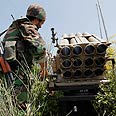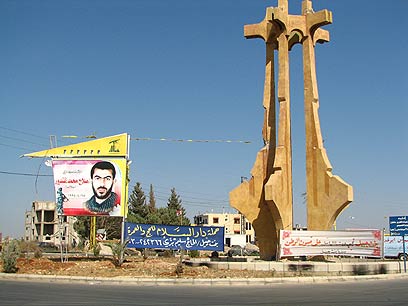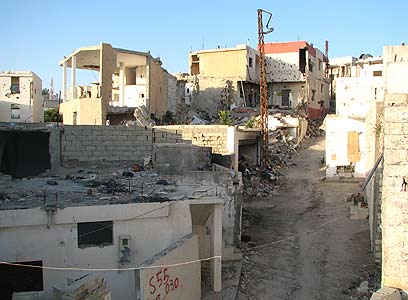
Part one of analysis by Ron Ben-Yishai
During a cold winter's day in late January on the Biranit mountain range, which overlooks south Lebanon, I noticed that dozens, if not hundreds of new buildings had been built in Bint Jbeil, Maroun al-Ras, Aita al-Shaab and Barmish. There is almost no remnant of the devastation the region sustained during the Second Lebanon War, and even without binoculars it was evident that the Shiite communities have expanded significantly compared with the few Christian-Maronite villages in the area, which remained the same size, more or less. This expansion was made possible in part by funds allocated by Iran and the Arab states towards the rehabilitation of the Shiite villages in the aftermath of the 2006 war with Israel, but it was mainly the result of Hezbollah's decision to revolutionize its preparedness for a conflict with Israel and move its forces from the open areas to the villages.
Hassan Nasrallah's organization has found that it is more difficult to deal with IDF soldiers and their superior firepower in open areas. Moreover, UN Resolution 1701 from 2006 forbids Hezbollah gunmen from carrying weapons in open areas. Therefore, Hezbollah has moved from bases in "nature preserves" to designated areas within the villages from which it can launch rocket or other attacks against Israel. The evacuated nature reserves no longer serve as permanent bases, and instead are meant to be used as bases for launching raids on Israeli communities in the Galilee.
At the same time, the Shiite terror group launched a major social/real-estate project that bolstered its political standing: It purchased lands on the outskirts of the villages, built homes on these lands and offered them to poor Shiite families at bargain prices (to rent or buy), one the condition that at least one rocket launcher would be placed in one of the house's rooms or in the basement, along with a number of rockets, which will be fired at predetermined targets in Israel when the order is given.
In addition, Hezbollah has set up camouflaged defense positions in villages which contain advanced Russian-made anti-tank missiles it had received from Syria. Hezbollah gunmen have planted large explosive devices along the access roads, and inside the villages structures that were purchased by the organization were converted into arms caches. The Hezbollah gunmen are focusing their efforts on finding ways to hide underground to protect themselves from IDF fire and to prevent Israeli intelligence from tracking them down so they will be able to continue fighting even when IDF forces are nearby.
In this manner some 180 Shiite villages and small towns situated between the Zahrani River and the border with Israel have been converted into fighting zones in which Hezbollah is preparing – above and below ground – for the next conflict with Israel. Hezbollah has some 65,000 rockets and missiles at its disposal.

Rockets in the basement. Bint Jbeil (Archive photo: Rinat Malkes)
Another issue, perhaps even more urgent, relates to Hezbollah's preparations for the day Syrian President Bashar Assad's regime collapses. According to experts, Hezbollah's leadership is aiding Assad not only because it was ordered to do so by Iran, but also because Nasrallah believed at the onset of the revolt that the Syrian president would be able to crush the opposition within a short period of time and then be indebted to the Shiite "brothers" from Lebanon and bolster the ties with them.
During the early days of his rule, Assad surprised Nasrallah on a number of occasions. He supplied Hezbollah with advanced weapons that his father Hafez Assad never even dreamed of transferring to the Lebanese terror group. Most of Hezbollah's heavy mid-range rockets and anti-tank missiles were supplied by Syria – not by Iran. But Nasrallah realized recently that he bet on a dying horse, and now he is trying to minimize the damage.

Bint Jbeil after the 2006 war (Archive photo: Rinat Malkes)
The Hezbollah leader is currently trying to transfer from Syria weapons he was supposed to receive – as part of a past agreement - only in the event of a military conflict with Israel. He is even making certain to maintain territorial contiguity between Shiite population centers in north Lebanon and the Alawite enclave that is gradually being established along the Syrian coastline. Moreover, Nasrallah is working to maintain his legitimacy inside Lebanon amid the criticism leveled at him by other ethnic groups over his support for the Assad family. However, he is focusing mostly on the preparations for a war with Israel.
Despite the fact that there are those in Israel who claim that the deterrence achieved against Hezbollah during the Second Lebanon War has been eroded, it is fairly clear that at this point Nasrallah's organization does not want to get involved in a major conflict with the Jewish state. Lebanon's national elections are scheduled for June, and Hezbollah does not want its political legitimacy and dominance to be challenged because it dragged the country into a devastating war with Israel. There is enough tension and violent clashes between Shiites and the Lebanese Sunnis, who are assisting the Syrian rebels trying to topple Assad.
However, it is also possible that Hezbollah will decide to attack us with full force if it gets the impression that Israel is planning to attack it first. As strange as it sounds to Israelis ears, Hezbollah sees us as an unpredictable and treacherous country that is capable of launching a preemptive surprise attack. For example, after the recent bombing of a Syrian convoy transporting anti-aircraft missiles, which foreign media outlets attributed to Israel, Hezbollah forces were placed on high alert for fear that the IDF would also attack targets in Lebanon. The alert level was lowered a few days later.
Part two of Ron Ben-Yishai’s analysis will be published Monday















